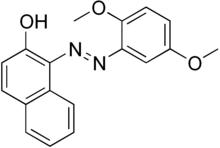| The examples and perspective in this article may not represent a worldwide view of the subject. You may improve this article, discuss the issue on the talk page, or create a new article, as appropriate. (February 2016) (Learn how and when to remove this message) |

| |

| |
| Names | |
|---|---|
| IUPAC name 1-(2,5-Dimethoxy-phenylazo)-naphthalen-2-ol | |
Other names
| |
| Identifiers | |
| CAS Number | |
| 3D model (JSmol) | |
| ChemSpider | |
| ECHA InfoCard | 100.026.162 |
| E number | E121 (colours) |
| KEGG | |
| PubChem CID | |
| UNII | |
| CompTox Dashboard (EPA) | |
InChI
| |
SMILES
| |
| Properties | |
| Chemical formula | C18H16N2O3 |
| Molar mass | 308.337 g·mol |
| Appearance | Orange to yellow solid or a dark red powder |
| Melting point | 156 °C (313 °F; 429 K) |
| Solubility in water | Insoluble |
| Hazards | |
| NFPA 704 (fire diamond) |
 |
| Except where otherwise noted, data are given for materials in their standard state (at 25 °C , 100 kPa).
| |
Citrus Red 2, Citrus Red No. 2, C.I. Solvent Red 80, or C.I. 12156 is an artificial dye. As a food dye, it has been permitted by the US Food and Drug Administration (FDA) since 1956 to color the skin of oranges. Citrus Red 2 is listed by the International Agency for Research on Cancer (IARC) as a group 2B carcinogen, a substance "possibly carcinogenic to humans".
Properties
Citrus Red 2 is an orange to yellow solid or a dark red powder with a melting point of 156 °C. It is not soluble in water, but is readily soluble in many organic solvents.
Use
In the United States, Citrus Red 2 is sometimes used to color oranges. It is only permitted to be used on the peel. It is permitted when the fruit is intended to be eaten, but is not permitted when the fruit is intended or used for processing, for example to manufacture orange juice.
References
- ^ Anonymous. 1988. Florida Citrus Fruit Laws. Florida Statutes. 601.
- ^ "Code of Federal Regulations: Title 21, Section 74.302". U.S. Food and Drug Administration. Retrieved 20 May 2014.
- Hall, David J (1989). "Peel Disorders of Florida Citrus as Related to Growing Area and Color-add formulations". Proc. Fla. State Hort. Soc. 102: 243–246.
- Agents Classified by the IARC Monographs Archived 2011-10-25 at the Wayback Machine, IARC